Independent Woman Part I: Rosie the Riveter
During WWII, millions of “independent women” contributed to the war effort in many different ways. In 1940, about 12 million women were in the workforce. By 1945, over 19 million were employed. In addition to the new women entering the workforce, there was a shift in the type of work being performed by those women who had already been in the workforce prior to the war. Women left lower paying jobs such as waitressing or domestic work for higher paying factory jobs, which could mean an average increase of up to 40% in salary. In addition to all of the women working in defense jobs, over 350,000 American women served in uniform, paving the way on a totally different front.
One of the most recognizable representations of a woman from WWII is J. Howard Miller’s poster girl, known popularly as Rosie the Riveter. During WWII, Rosie the Riveter was joined by her sisters, Wendy the Welder, Bertha the Burner, Jenny on the Job and Ronnie the Bren Gun Girl. But Rosie, conceived as a propaganda pin-up, has crossed generations to stand as a sometimes contested symbol for female empowerment. The concept and icon of “Rosie the Riveter,” continues to be adapted and used as a symbol for power and a testament to the spirit of the American woman.
The evolution of the Rosie icon is complex. There are several iterations of what is known popularly as “Rosie the Riveter.” Technically, the icon stems from the 1942 hit song by the same name written by Evans and Loeb. This inspired artist Norman Rockwell’s painting, Rosie the Riveter, debuted on the cover of the 1943 Memorial Day issue of the Saturday Evening Post. Rockwell’s Rosie means business and is a true multi-tasker, balancing a rivet gun in her lap, eating a sandwich, and nonchalantly stepping on a copy of Hitler’s Mein Kampf. The “Rosie” cover was one of Rockwell’s most popular and the original painting sold at Sotheby’s in 2002 for nearly $5 million.
J. Howard Miller’s depiction of a female worker from February 1943 presents a more glamorized image than Rockwell’s. She wears a red bandana, denim work shirt, flexes a bicep and is quoted, “We Can Do It!” Her message emphasizes the collective (“We”) rather than the individual (“I”) necessary for achieving victory. The poster was commissioned by the Westinghouse Corporation for a campaign to spur production among women workers. Miller’s poster, and the campaign, was designed to run for two weeks throughout Westinghouse factories.
Miller’s image has outlived its two weeks by more than seventy years. It has endured and evolved with cultural shifts. Like other iconic propaganda works—the British “Keep Calm and Carry On,” and Uncle Sam’s “I Want You,” “Rosie” has been adapted and adopted by many disparate causes and campaigns. See the tremendous popularity of any of these posters by a simple search on the internet; anyone can make their own version of it, even on our own site! Rosie’s message serves as a blank canvas which is often employed to convey rallying cries of all stripes. Rosie’s red bandana has been sported by Marge Simpson, Sarah Palin, Princess Leia, Wonder Woman, Kelly Rowland, and most recently by Beyoncé during a visit to The National WWII Museum.
The photo-op captured by the famous “independent woman” at the Museum (which so far has received 1.15 million likes on Instagram) is an activity that any visitor to the Museum can engage in. “Become a Propaganda Poster” features not only the “We Can Do It!” poster, but also the rationing campaign poster “Do with Less so They’ll Have Enough” for which visitors can don a steel-pot helmet and raise a canteen cup. Beyond the dress-up, the Museum has extensive artifacts and oral histories from “real” Rosies and we are committed to telling their stories.
We collected one such story as an oral history last month. In 1942, Mildred Aupied was a twenty-year-old secretary for the phone company when she heard a call for women welders. She jumped at the chance to attend welding school and within two months, she and 24 other women immediately began welding Liberty Ships at Delta Shipbuilding Company in New Orleans. In her interview, she stressed her pride at having learned and mastered a new and challenging trade. The women at Delta Shipbuilding relished the opportunity, the pay, and the camaraderie. In addition, all of this hard work was to benefit their country during a time of tremendous labor shortage and need.
Women played important roles in WWII, motivated by both patriotism and paychecks. The fight for equality was one that would continue postwar into the present day. Learn more about American Women in WWII on the Home Front and Beyond. See other Museum posts tagged with Rosie.
- J. Howard Miller's Rosie the Riveter.
- Norman Rockwell's Rosie the Riveter
- Antoinette “Toni” Miller (later Tamburo) worked as a clerk at the Higgins Aircraft facility in New Orleans. Gift of Theresa Tamburo,2013.072
- Like many other women who worked during WWII, Toni Miller saved her pay stub as reminder of her wartime contributions. Toni worked over twenty hours of overtime and also put $11.25 of her total $88.11 toward war bonds. Gift of Theresa Tamburo, 2013.072.002
- We Can Do It! Our Summer Science campers posing as Rosie.
- The women welders of Delta Shipbuilding Company on January 7th, 1943. Mildred Aupied is in the top row, seventh from the left. The National WWII Museum, 2014.
- The women welders of Delta Shipbuilding Company. Mildred Aupied is on the far right. The National WWII Museum 2014.
- Museum employees posing as Rosie.
Post by Curator Kim Guise and Virtual Classroom Coordinator Chrissy Gregg
- Posted :
- Post Category :
- Tags :
- Follow responses to this entry through the RSS 2.0 feed. You can skip to the end and leave a response. Pinging is currently not allowed.



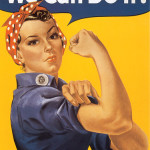
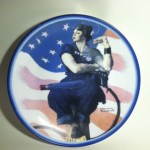
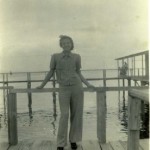
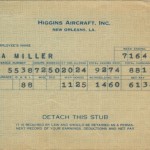

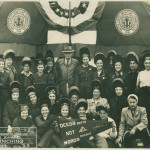
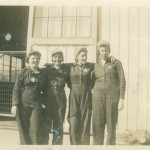



Leave a Reply